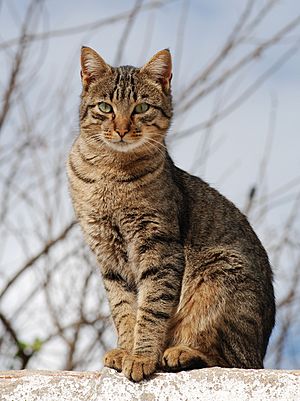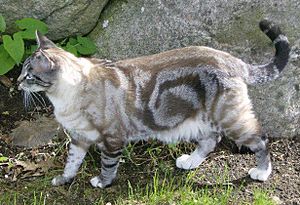Tabby cat facts for kids

A tabby cat is a domestic cat with cool patterns like stripes, dots, or swirls on its fur. You'll often see an "M" shape on their forehead! Tabbies aren't a specific cat breed; it's just a type of coat pattern. They are super common – about two out of every three cats in the world are tabbies!
This unique pattern comes from their wild ancestors, like the African Wildcat, which also has similar markings.
Contents
Tabby Patterns

There are four main tabby patterns. These patterns are different because of the cat's genetics. They are: mackerel, classic, spotted, and ticked.
There's also a fifth pattern called "patched" tabby. This is when a calico or tortoiseshell cat has tabby patterns mixed into its colorful patches. People sometimes call them "caliby" or "torbie" cats.
Mackerel Tabby
The mackerel tabby is the most common and is thought to be the original tabby pattern. These cats have narrow, parallel stripes running down their sides, like a tiger. This is why some people call them "tiger" cats!
They also have an "M" shape on their forehead and dark lines across their cheeks. Their legs and tail have dark bars. Mackerel tabbies are sometimes called "Fishbone tabbies" because their stripes look a bit like the bones of a mackerel fish.
Classic Tabby
The classic tabby cat is also known as "blotched" or "marbled." They often have colors like dark brown, ochre, or black, but can also be grey. Like other tabbies, they have the "M" pattern on their forehead.
Their body has a swirled or whirled pattern on its sides, which often looks like a "bullseye." They also have a light-colored "butterfly" pattern on their shoulders. Three thin stripes run along their spine, with the middle one being dark. Classic tabbies also have dark stripes on their legs, tail, and cheeks. This pattern is less common than the mackerel tabby.
Ticked Tabby
A ticked tabby pattern makes the fur look "grizzly" or "salt-and-pepper." This happens because each hair has different bands of dark and light color. This breaks up the usual tabby stripes.
You might still see some stripes or bars on their lower legs, face, belly, and sometimes at the end of their tail.
Spotted Tabby
The spotted tabby has a special gene that breaks up the mackerel tabby stripes into spots. Sometimes, the stripes of a classic tabby can also be broken into larger spots.
Both large and small spot patterns can be seen in cat breeds like the Australian Mist, Bengal, Egyptian Mau, Maine Coon, and Ocicat.
Tabby Colors
Tabbies come in many colors like brown, grey, orange, or even calico. They can also have lighter, "dilute" versions of these colors. Brown is the most common tabby color.
All orange cats are tabbies, and any orange part of a calico cat will always show tabby patterns. Since the gene for orange color is on the X chromosome, most orange tabby cats are male. Almost all calico cats are female.
Cats with colorpoint patterns (like Siamese or Himalayan) that are tabbies are called "lynx point." Tabbies can also have white patches, like tuxedo or van patterns. The tabby pattern won't be visible in the white parts of their fur.
History of Tabby Cats
The mackerel tabby pattern was the first tabby pattern seen in domestic cats. It is believed to have come from the African Wildcat and the European Wildcat. Both of these wild cats have a pale, striped tabby pattern. When these wild cats mixed, it led to the more distinct mackerel tabby coat we see today.
At first, the mackerel tabby was common in all domestic cats. Over time, other tabby patterns appeared because of natural changes in genes (called mutations) and through people choosing which cats to breed (called selective breeding). All domestic cats have the tabby gene, but in some cat breeds, other genes hide the tabby pattern.
See also
Images for kids
-
A European wildcat (F. s. silvestris) with a coat pattern similar to a tabby cat.
See also
 In Spanish: Gato atigrado para niños
In Spanish: Gato atigrado para niños







